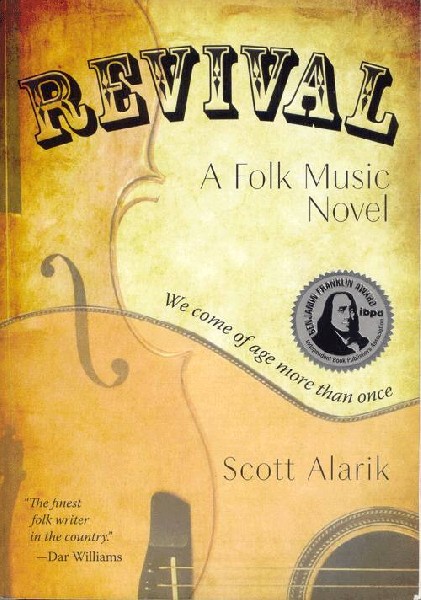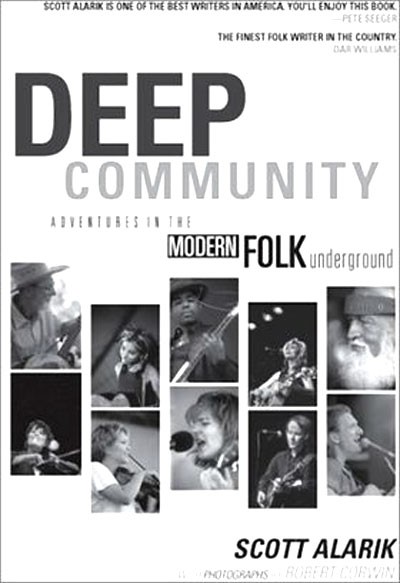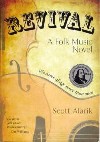Revival - A Novel by Scott Alarik
A Fable Of The Cambridge Folk Community
By: David Wilson - Oct 20, 2013
Revival
A Folk Music Novel
by Scott Alarik
As heroic protagonists, folksingers are unlikely choices save in the songs they may write about themselves and then, if wise, sing only to themselves. While I finished Scott Alarik’s Revival, a novel with a heroic folksinger as the primary character a few months ago, I have been letting the experience stew
Everyonceinawhile, stewing gives rise to a plausibility, a thought, a connection. Recently one such reminded me that half a century ago I was taken by another folksinger hero, a wanderer with a guitar who oft showed up in the boonies, drawn by prescience of supernatural malevolency. Through his uncommon knowledge of traditional ballads and their encoded knowledge plus his silver stringed instrument, he thwarts the evil forces and everyone, save the demon, lives, if not always happily at least a little wiser thereafter. John or "John the guitar picker" was the protagonist of five novels and several short stories by the prolific science fiction and fantasy writer, Manly Wade Wellman.
There are a number of parallels between Wellman’s John and Alarik’s Nathan as well as some contrasts and there is a thread between the John tales and the Cambridge folk community that while subtle is quite real. I’ll save that for the end.
Alarik is by no means an unbiased observer. His credentials are extensive and diverse. He has been a folk performer, a songwriter, has written folk music commentary for the Boston Globe and published an earlier collection of his writings, “Deep Community: Adventures in the Modern Folk Underground.” His renown as a chronicler of the folk scene leaves me green with envy.
In Revival, Nathan Warren, folk singer, open-mic M.C., recovering alcoholic, a bit long on the vine, but still vital meets, courts and mentors Kit Palmer over the course of several seasons. Kit is, budding and juicy, to Nathan, forbidden fruit, though within short order the unwitting temptress overcomes his reserve and they establish a loving relationship with no more than a few bumps and blunders most of which are the result of a lack of self confidence on the part of each of them. Nathan is as much drawn to her by her creative genius and generous nature as by her physical attractions. His emotional concern and his support for her artistry groom her for popular success. Through the course of the events we are introduced to a supporting cast of characters generically familiar to anyone who has spent much time in the world of folk performers. Murphy, the bartender, represents the host of venue service people who are as connected to the music, though often a bit more cynical, than the fans themselves. Ferguson is the critic, writing about the music and reviewing performers and performances, promoting what he perceives as artistic honesty and, less often, devastating those whose artifice overshadows their talent. Ryder, the aspiring musical celebrity falls into that latter category, Kit into the former. We also meet two other characters who typify archetypes within the folk community. Randy is a nerdy member of a college faculty. His love and understanding of the music will never be matched with enough talent to perform at a professional level, yet he risks ridicule for the joy of participating in open-mics. Add Joyce, the consummate professional who rode her talent to national prominence, jaded without being heartless and oh yes, I need mention, once married to Nathan.
Whereas the aforementioned protagonist, John, confronted threats embodied in evil and demonic form, Nathan must confront the demons within himself, choices made in the past, his perception of a failed career, a broken marriage, his fears of repeating the same mistakes again and the amorphous music industry steamroller, all of which result in an extended near paralysis of action and spirit. John has his silver stringed guitar for back-up while Nathan has only his friends, their faith and affection for him and his love for his music as aids.
As I read back to myself what I have written above I am thinking, “My God. What a formula for a mess.” Far from it, Scott Alarik has enough understanding of his characters, enough affection for them and a deep understanding of the milieu through which they make their way. Added to that is a down to earth, plain as dirt, homespun way of telling a story that had me savoring every page, ticking off my own comparable memories of colleagues and performers I have known who could easily have been the model for one or another of these characters.
Along the way, Scott, the teacher, shows us how the folk process takes the experiences of real people, distills and preserves them in a way that they become accessible to generations beyond their event. He addresses the futility of the temptation to define and therefore limit folk music. One illustration of this point occurs when he notes that proponents of traditional Celtic music once decried the introduction of the fiddle as the ruination of the genre.
But even more significant to my mind is the inherent recognition that those who achieve that level of popular approval that provides economic success, do so only with the combined contributions of a multitude. For every star performer is supported by ranks of other superb musicians giving their efforts to enhance the star’s performance whether on-stage or in the recording studio. And that star and those musicians are in turn supported by even greater numbers of technical personnel, instrument makers, countless venue proprietors operating on a shoestring, a wait staff as dedicated to the music and musicians as to their tips, crowds of talented amateurs who trumpet the songs and skills of those they admire during their own performances and a plethora of just plain folk music fans who care as much for their music and those who represent the best of it as they often do their own family, sometimes more.
Yes, I have some quibbles. Nathan’s choices in the end, (without spoilers,) raise questions in my mind about the path along which he has guided Kit. Why is one path right for him, while he deems another better for her? While Nathan’s alcohol dependency is addressed, there is little or no mention of other drugs common to the scene. The characters are all a bit more idealized beyond any I have ever met and there is a striking lack of anyone without a vanilla name. For those reasons, I tend to look upon this as a fable, but find it no less satisfying for that.
This is not a perfect novel, nor a perfect first novel. Out of the thousands of books I have read, I have reread less than two dozen, yet this is one I expect to read again, if only to spend some more time with the characters and the familiar Cambridge surroundings wherein most of the events occur .
Looking back I see that I have written what might be considered a belittling description of the John stories and that is not my intent. Manly Wade Wellman was a notable if underappreciated writer. In 1946 he bested William Faulkner much to that paragon’s dismay in an award competition.
Oh, yes, that subtle connection I spoke about back in the beginning. Manly Wade Wellman was friend and neighbor to North Carolina traditional banjoist, Obray Ramsey to whom he credits much of the lore he used in his tales. A Boston performer who also received instruction on ballads and banjo from Obray Ramsey was one Mel Lyman, best know musically for his role with the Kweskin Jug Band and elsewhere for his founding of the Fort Hill Community.
A video interview with Scott







